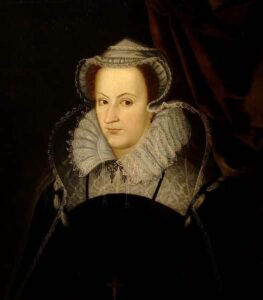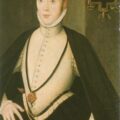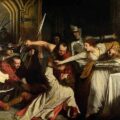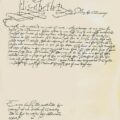
What was important about these letters?
Well, the eight letters found in the casket were allegedly written by Mary to Bothwell and one was said to implicate the couple in the murder of Mary’s second husband, Henry Stuart, Lord Darnley, who had been murdered in February 1567. Elizabeth I ordered a commission to investigate the matter of Mary’s involvement in Darnley’s murder and on the 14th December 1568 the letters were produced at the Royal Commission as proof against Mary.
In his excellent book on Mary Queen of Scots, “My Heart is My Own”, historian John Guy writes:-
“The sole evidence that she was a part to the murder plot comes from them [the Casket Letters]. There is no other proof. Her guilt or innocence depends on whether the letters are true or false.”1
The Casket Letters no longer exist, so cannot be examined today, but we still have the transcripts and translations, complete with William Cecil’s notes. It is these notes which Guy says give us a “glimpse” into Cecil’s thoughts as he read letters that were “dynamite” in that if they were indeed genuine then “an anointed Queen could justifiably be deposed from her throne, Elizabeth’s ‘safety’ would be guaranteed, and the threat of an international Guise conspiracy ended for ever”2. However, if they were forgeries then Mary would have to be released because it could not be proved that she was complicit in Darnley’s murder.
The Sonnets
John Guy writes of how the sonnets found in the casket “were said to be Mary’s own reflections on her adultery”3 with Bothwell and proof “that her consuming passion for Bothwell gave her a powerful motive for murder.”4 However, Guy points out that they are highly unlikely to be genuine as “they are extremely clumsy and would pass only with the greatest difficulty as the work of a native French speaker”5 and they do not fit with the “genre of courtly love poetry”6 with which Mary was familiar. He also points out that they can be read as religious poetry.
The Marriage Contracts
One of the marriage contracts from the silver casket was said to be dated 5th April 1567 “at Seton”, so over a month before Mary and Bothwell’s marriage, but Guy points out that this is a “blatant forgery” because the wording of the contract included “extracts from the Ainslie’s Tavern bond”7, a document which was produced after the gathering of the Lords at Ainslie’s Tavern on the 19th April 1567. The other contract Guy describes as “innocuous” because “it is less a ‘contract’ than a written promise by Mary to marry Bothwell”8.
The Casket Letters
Letters 1 and 2, “the short Glasgow Letter” and “the long Glasgow letter” were the most damning and the second letter, if genuine, was proof that Mary was Bothwell’s lover before their marriage and that she had been involved in Darnley’s murder. Letter 2 contained “seemingly graphic allusions to the murder plot… interspersed with its author’s protestations of longing and desire for her lover”9 and Guy explains that the case against Mary rested on seven key extracts from the letter. You can read Guy’s full thoughts on the letter in “The Casket Letters” chapters of his book, but he argues that only the fifth extract, which said “Think also if you will not find some invention more secret by physick, for he is to take physick at Craigmillar and the baths also. And shall not come forth of a long time”10, can be connected to a murder plot. Guy explains that this extract was meant to prove that Mary wanted Darnley to be poisoned while he was at Craigmillar but it is not evidence of the plot which actually killed Darnley at Kirk o’Field. Also, Guy argues that “it has to be regarded as a later forged interpolation”11 because it was missed in the material that was sent by George Buchanan to William Cecil in June 1568 and only used in the final accusations laid against Mary by the Confederate Lords to prove that Darnley’s illness, which was in fact syphilis, was caused by poisoning. This charge does not make sense though as Darnley was already ill at this time.
After examination of the transcripts and translations, Guy concludes that, “in the absence of the original handwritten pages” of Letter 2, “around 1500-1800 words are likely to be genuine” and that 1000-1200 words are “likely to interpolations”12 from later letters or forgeries. It could well be that “old and new pages were spliced together to make up a composite document”13 to convince Cecil and Elizabeth of Mary’s guilt.
The controversy and debate over these letters still continues today and I would recommend John Guy’s book “My Heart is My Own: The Life of Mary Queen of Scots” to anyone interested in The Casket Letters or Mary Queen of Scots in general.
Notes and Sources
- My Heart is My Own: The Life of Mary Queen of Scots, John Guy, p396
- Ibid., p398
- Ibid., p399
- Ibid.
- Ibid.
- Ibid.
- Ibid., p400
- Ibid.
- Ibid., p404
- Ibid., p413
- Ibid., p415
- Ibid., p416
- Ibid., p417









IMO, there is other evidence of Mary’s guilt (Mary hated him; she had pardoned his cohorts in the Rizzo murder who hated him for betraying them; she got Darnley out of the safety of his father’s Glasgow stronghould to Edinburgh, where she had no guards stationed to protect him) so I am not sure why the Casket Letters are considered so important. Maybe, the adultery was critical?
I think the letters were just for furhter ‘hard’ evidence to convince Elizabeth because she did NOT want to execute Mary–though she was pretty unhappy about Mary’s behavior. No one could have invented Mary Queen of Scots–she is an amazing figure–thanks for the info on the casket letters—I wish we could find out the full extent and what was true and what not. That business with Bothwell—too much!
He must have been something!
The Casket Letters did not PHYSICALLY exist until December 1568, 22 months after Darnley’s murder. That was when Lord Moray produced them at the inquisition into Darnley’s murder. Before that time they were only verbally referenced by Moray but he was unable to produce them until December 1568. So the letters did not exist until December 1568 accept as verbally per one of the Darnley murder suspects, Lord Moray, the person who profited the most by Darnley’s murder. Morton testified to the inquisition that he found them in a coffer/ casket June 20, 1567 but the British State papers indicate that he found the coffer/casket on July 12, 1567 and that within there were Jewels, NOT letters. See entry #1433, July 12. http://www.british-history.ac.uk/report.aspx?compid=72127
That’s why I said “allegedly” because there is so much controversy regarding these letters. I agree with Dr John Guy’s thoughts on the letters (see towards the end of the article), that “in the absence of the original handwritten pages” of Letter 2, “around 1500-1800 words are likely to be genuine” and that 1000-1200 words are “likely to interpolations”12 from later letters or forgeries. It could well be that “old and new pages were spliced together to make up a composite document”13 to convince Cecil and Elizabeth of Mary’s guilt.